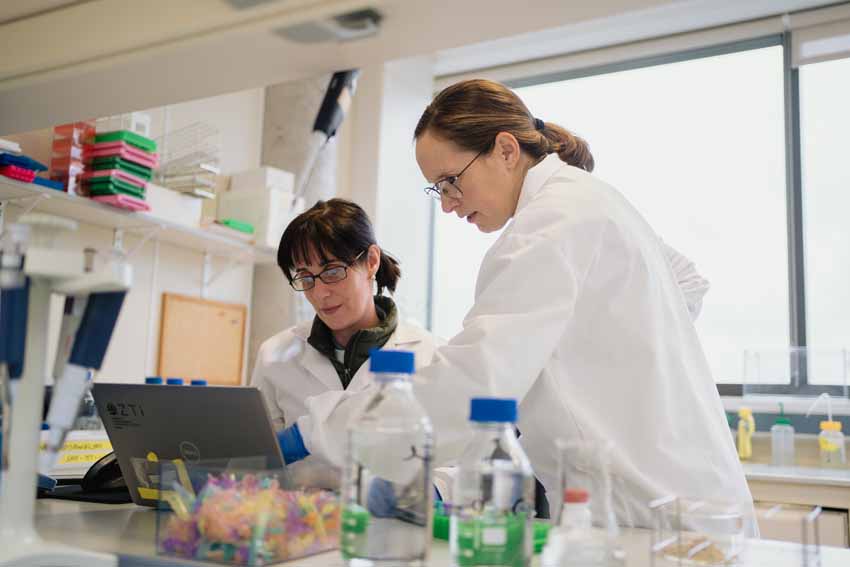Ingredients with Technological Functionality: Innovation for a More Efficient and Sustainable Food Industry
Últimas noticias
[EATrends] Simple and Clear: Building Trust in an Age of Skepticism
When Marine Science Doesn’t Reach Shore: Why Better Communication Can Help Save the Ocean
[EATrends] Food (In)security: A Defining Challenge for the Next Decade
SAIOA ALVAREZ-SABATEL and ESTHER SANMARTÍN, Researchers at New Foods
Índice de contenidos
- Technological Functionality as a Driver of Food Innovation
- What Do We Mean by Technological Functionality?
- Seeking the best functional properties for strategic use in food design
- OPTIPROT and 3SLEKA: Advancing Ingredient Functionality
- AZTI’s Capabilities for Assessing Ingredient Functionality
- Why collaborate with AZTI?
Technological Functionality as a Driver of Food Innovation
In a world where sustainability, health and industrial efficiency are top priorities, ingredients with technological functionality are emerging as key allies in transforming the food sector. These ingredients not only contribute nutritional value, but also enhance the physical, chemical, structural and sensory properties of food products.
What Do We Mean by Technological Functionality?
The technological functionality of ingredients refers to the set of physical, chemical and structural properties that allow an ingredient to influence how a food matrix behaves during processing, storage and consumption. Among these properties are:
• Solubility and dispersibility in different matrices.
• Water- and fat-holding capacity.
• Emulsifying and foaming ability.
• Impact on texture, viscosity, appearance and other sensory characteristics of the final product.
• Stability and performance under different processing and matrix conditions (temperature, pH, time, salinity, etc.).
• Interaction with other components in the formulation.
Seeking the best functional properties for strategic use in food design
Technological functionality is not a secondary feature—it is essential to ensure that an ingredient can be properly integrated into a food formulation, maintaining product quality, stability and consumer acceptance, while maximising the potential contribution of each ingredient.
Moreover, as the search for new food sources intensifies—such as agri-food by-products, algae, insects or alternative crops—assessing their technological functionality becomes vital. It is not enough for an ingredient to be healthy or sustainable; it must also perform effectively within food matrices to ensure its industrial viability.
Understanding and strategically applying the technological functionalities of ingredients also enables the design and development of “tailor-made food structures”, allowing, for example:
• The modulation of texture and sensory perception.
• Adaptation of food structures for different consumer groups (children, older adults, people with dysphagia, etc.).
• Controlled release of bioactive compounds.
• Optimisation of nutrient bioavailability.

OPTIPROT and 3SLEKA: Advancing Ingredient Functionality
Through projects such as OPTIPROT, 3SLEKA and MINDFOODNESS, AZTI has developed innovative solutions for obtaining and characterising functional ingredients from sustainable sources.
- OPTIPROT: Funded by the MCIU–CDTI and the European Union’s NextGenerationEU/PRTR programme, this project focuses on obtaining highly functional protein ingredients from new sources, providing the food industry with tools to develop healthy foods and ingredients using alternative proteins.
- 3SLEKA: Funded by the Basque Government, this project generates knowledge and technology for developing new ingredients and foods based on safe, healthy and sustainable legumes.
- MINDFOODNESS: Also supported by the Basque Government, this initiative explores the extraction and use of technologically functional ingredients from new, safe and sustainable food sources.
These projects reflect AZTI’s commitment to applied research and the transfer of knowledge to the business sector.
AZTI’s Capabilities for Assessing Ingredient Functionality
At AZTI, we have advanced infrastructure and methodologies to study the technological functionality of ingredients under different conditions—both in isolation and within food matrices. Our characterisation methods include:
- Rheology, texture analysis and tribology to study texture, mechanical behaviour and frictional properties.
- Evaluation of foaming, emulsifying, solubility and dispersibility properties.
- Stability studies, including thermal and pH stability.
- Sensory and consumer acceptance testing.
- Simulation of industrial processes to validate performance under real production conditions.
These capabilities help companies reduce risks, accelerate product development and improve process efficiency.
Why collaborate with AZTI?
Partnering with AZTI gives you access to a multidisciplinary team with expertise in food science, process engineering and sensory analysis. Our goal is to support companies in developing customised, sustainable and competitive solutions.
Moreover, our involvement in projects such as OPTIPROT, 3SLEKA and MINDFOODNESS keeps us at the forefront of ingredient functionality, allowing us to anticipate trends and generate practical knowledge for the food industry.
Want to learn more?
If your company is interested in developing innovative products, improving formulations or exploring new sources of technologically functional ingredients, AZTI can help.
Get in touch with our team to learn more about our capabilities and explore collaboration opportunities.









